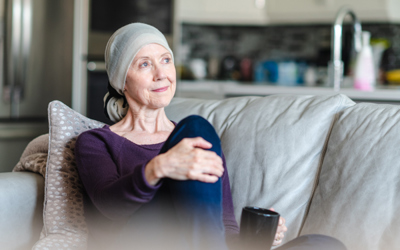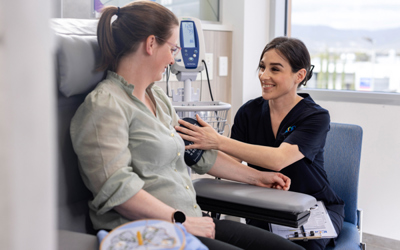What are the treatment options for stomach cancer?
The primary treatment options for stomach cancer include surgery, chemotherapy and radiotherapy. The type of treatment you receive will depend on a number of different considerations, such as the type of stomach cancer you have, its stage, your overall health and your treatment preferences. This page aims to give you a comprehensive overview of how stomach cancer treatment works.
Surgery for stomach cancer
Most people with stomach cancer will receive surgery at some point in their treatment, with the goal of keeping as much healthy tissue as possible while ensuring that all of the cancer has been removed.
There are a number of surgeries you may receive depending on the size and stage of your cancer and its location within the stomach.
-
Endoscopic resection
This procedure involves an endoscope which is passed down the throat and into the stomach to remove small cancerous tumours and layers of the stomach wall. This is a treatment option for very early-stage stomach cancer which has not grown deeply into the stomach wall.
-
Subtotal or partial gastrectomy
For people with cancer confined to a small section of the stomach, this surgery involves the removal of part of the stomach alongside the omentum and nearby lymph nodes. If the cancer has spread outside of the stomach to nearby organs, parts of these may also need to be removed. This surgical procedure has a much smaller impact on normal eating habits compared to removal of the entire stomach.
-
Total gastrectomy
This surgery is performed if the cancer has spread extensively within the stomach. It involves the removal of the entire stomach, the omentum and nearby lymph nodes, in addition to any other affected parts of organs such as the spleen, oesophagus or intestine. The oesophagus is then connected to the small intestine. People who receive a total gastrectomy will no longer be able to eat large amounts of food and may experience side effects from eating too quickly.
-
Lymphadenectomy
This involves the removal of any nearby lymph nodes that have been affected by cancer.
-
Open gastrectomy or laparotomy
A long incision is made through the skin and abdominal wall to access your stomach and other internal organs.
-
Laparoscopic gastrectomy
A minimally invasive procedure that uses several small incisions to access the stomach. Laparoscopic procedures result in less postoperative pain and complications, shorter hospital stay and faster recovery compared to open gastrectomy.
-
Robotic-assisted gastrectomy
This procedure uses a robotic system to perform laparoscopic gastrectomy remotely, allowing greater precision in comparison to standard laparoscopic surgery.
Radiotherapy for stomach cancer
Radiotherapy for stomach cancer can be used in a number of ways:
As chemoradiation together with chemotherapy to help shrink the size of the stomach cancer cells before surgery
After surgery to help destroy any remaining stomach cancer cells and prevent them from spreading and growing elsewhere
To help relieve symptoms such as pain for advanced or metastatic stomach cancer
External beam radiotherapy
Stomach cancer patients who have radiotherapy will usually receive external beam radiotherapy (EBRT). External beam radiotherapy is used to treat stomach cancer by delivering highly targeted radiation beams to the stomach and other areas where cancerous cells have been detected.
Intensity modulated radiotherapy
The most common type of EBRT treatment for stomach cancer is intensity modulated radiotherapy (IMRT). This is a technique that uses 3D mapped images of the stomach cancer to deliver high dose radiation while limiting the impact on surrounding healthy tissue.
Chemotherapy for stomach cancer
Chemotherapy uses a range of drugs to kill and slow the growth of stomach cancer cells. Stomach cancer patients can receive chemotherapy alone, alongside radiotherapy (a treatment method known as chemoradiation) or after surgery (adjuvant chemotherapy). While chemotherapy can be delivered in a number of different ways, it is most common for stomach cancer patients to be given chemotherapy intravenously. When you are treated with chemoradiation, your radiotherapy will begin on the same day as your first chemotherapy treatment.
Learn more about chemotherapy and how it is delivered.
Chemotherapy treatment for stomach cancer takes place over several sessions, known as a cycle. Your care team will walk you through how many cycles you may need for your course of treatment, with most people completing chemotherapy in a period of three to six months.
Common chemotherapy medicines
Chemotherapy medications can be given together with radiotherapy to increase the effectiveness of the radiation (chemoradiation). They are usually given as a combination of two or more drugs. Common drugs include:
-
Capecitabine and oxaliplatin
This combination is commonly used as part of adjuvant chemotherapy or to treat advanced or metastatic stomach cancer. Oxaliplatin works by preventing cancer cells from making the DNA material they need to divide and grow. Capecitabin is a prodrug which is converted to its active form, fluorouracil, in the body. Oxaliplatin is given by intravenous infusion while oxaliplatin is given orally by mouth as a tablet or capsule.
-
Fluorouracil and leucovorin
Fluorouracil works by preventing cancer cells from being able to make the genetic material (RNA and DNA) that they need to reproduce. It is often given in combination with leucovorin which helps to increase its action against stomach cancer cells. These drugs are used in combination with other chemotherapy drugs to treat advanced or metastatic stomach cancer and may also be used as adjuvant or neoadjuvant chemotherapy after surgery. They are usually given by intravenous infusion every two to three weeks.
-
Paclitaxel and docetaxel
These chemotherapy drugs work by interfering with normal cell structures and how they function. They are used to treat advanced or metastatic stomach cancer and are usually given by intravenous infusion every one to three weeks, with each infusion taking around 90 minutes.
-
Cisplatin
This type of chemotherapy drug is a platinum compound that works by binding to and damaging DNA within cancer cells, preventing them from being able to divide and grow. It is usually used in combination with other chemotherapy or targeted therapy drugs for advanced or metastatic cancer, or as adjuvant chemotherapy after surgery. Cisplatin is given by intravenous infusion.
-
Irinotecan
Irinotecan works by blocking an enzyme called topoisomerase 1, which cancer cells need to replicate. It is used to treat advanced or metastatic stomach cancer, and is typically given by intravenous infusion every two to three weeks.
Targeted therapies for stomach cancer
Targeted therapies use specialised drugs to destroy specific proteins in stomach cancer cells.
Common targeted therapy medicines
Common targeted therapy drugs that are used to treat stomach cancer include:
-
Trastuzumab
This is a type of monoclonal antibody that works by blocking a protein known as HER2 (human epidermal growth factor receptor 2) which stimulates the growth of cancer cells. When the HER2 protein is found in excessive amounts on the cells of some types of stomach cancers, it is called HER2 positive stomach cancer. Blocking the HER2 protein helps to prevent the cancer cells from growing and spreading. Trastuzumab is used to treat advanced or metastatic stomach cancer and can be used alone or in combination with other chemotherapy drugs such as cisplatin and fluorouracil. It is given by intravenous infusion.
-
Ramucirumab
This works by preventing the supply of blood vessels that provide nutrients to cancer cells. It is used to treat advanced or metastatic stomach cancer and may be given alone or in combination with other chemotherapy drugs. It is usually given by intravenous infusion every two weeks, with each infusion taking around 90 minutes.
Clinical trials for stomach cancer
Icon offers a wide range of clinical trials providing patients with access to new and evolving treatments. Clinical trials offer hope and opportunity and contribute to breakthroughs in treatment for future cancer patients.

Treatment by stage of stomach cancer
When you are diagnosed with stomach cancer, your oncologist will develop your treatment plan as part of a multidisciplinary team based on the stage of your cancer.
Common treatment options for each stage of stomach cancer include:
Stage 0 (early-stage) stomach cancer
If the cancer has not grown deeply into the stomach wall, surgery by endoscopic resection will usually be recommended to remove the cancer and any affected lymph nodes. You may receive chemotherapy and radiation before surgery to help shrink the tumour or after surgery to destroy any remaining cancer cells.
Stage I stomach cancer
Depending on the size and location of your cancer, you may receive surgery to remove the cancer from within your stomach. If surgery isn’t a suitable option or possible based on other health reasons, you may receive different treatments such as chemotherapy alone, chemotherapy and radiotherapy or chemotherapy and targeted therapy.
Stage II stomach cancer
In stage II stomach cancer, surgery is a common treatment option to remove cancerous cells within the stomach and any affected lymph nodes. You may have radiotherapy and/or chemotherapy before surgery to help shrink the cancer cells or after surgery to help destroy any remaining cancer cells and prevent the cancer from returning in the future.
Stage III stomach cancer
At this stage, surgery is usually performed to remove cancerous cells and affected lymph nodes where possible. You may have radiotherapy treatment before your surgery (neoadjuvant radiotherapy) to help to shrink the cancer cells. Your treatment may also include chemotherapy alone, chemotherapy and radiotherapy or chemotherapy and targeted therapy.
Stage IV (advanced) stomach cancer
If the cancer has spread to other areas of the body, the goal of treatment is to control the growth and spread of your cancer and to relieve any symptoms it may be causing. You may receive chemotherapy or chemotherapy alongside a targeted therapy. Radiotherapy may be used to help stop the spread of cancer and to relieve symptoms such as pain, bleeding and difficulty swallowing.









